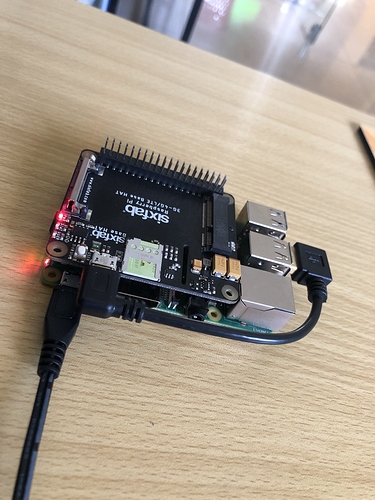I hope it is OK to jump into this thread. I get the nearly the same error (different linux) as @blynkgdp with this command:
sudo ./files/quectel-CM/quectel-CM -s internet
[09-24_15:31:41:938] Quectel_QConnectManager_Linux_V1.6.0.12
[09-24_15:31:41:942] network interface ‘’ or qmidev ‘’ is not exist
[09-24_15:31:41:942] qmidevice_detect failed
[09-24_15:31:41:942] qmidevice_detect failed
SETUP
RPi Hat, Telit LE910C1 *does the Telit have a different software install?
debian version 9.13 (command: cat /etc/debian_version)
The error comes after following the QMI Interface with Base HAT instructions and running the last command sudo ./quectel-CM -s internet (and I tried iot.simon and IoT.simon for my APN as well).
Output for uname -r is 4.19.66-v7+
Output for 'lsusb -t' is as follows:
/: Bus 01.Port 1: Dev 1, Class=root_hub, Driver=dwc_otg/1p, 480M
|__ Port 1: Dev 2, If 0, Class=Hub, Driver=hub/4p, 480M
|__ Port 1: Dev 3, If 0, Class=Hub, Driver=hub/3p, 480M
|__ Port 1: Dev 5, If 0, Class=Vendor Specific Class, Driver=lan78xx, 480M
|__ Port 2: Dev 4, If 0, Class=Vendor Specific Class, Driver=option, 480M
|__ Port 2: Dev 4, If 1, Class=Vendor Specific Class, Driver=, 480M
|__ Port 2: Dev 4, If 2, Class=Vendor Specific Class, Driver=qmi_wwan, 480M
|__ Port 2: Dev 4, If 3, Class=Vendor Specific Class, Driver=option, 480M
|__ Port 2: Dev 4, If 4, Class=Vendor Specific Class, Driver=option, 480M
|__ Port 2: Dev 4, If 5, Class=Vendor Specific Class, Driver=option, 480M
|__ Port 2: Dev 4, If 6, Class=Vendor Specific Class, Driver=option, 480M
After trying to complete the tutorial suggested by @ensar, I get stuck on the following:
sudo qmicli -d /dev/cdc-wdm0 --wda-get-data-format
returns:
[24 Sep 2020, 21:10:35] -Warning ** Error reading from istream: Resource temporarily unavailable
error: couldn’t create client for the ‘wda’ service: CID allocation failed in the CTL client: Transaction timed out
And of course I still get the same original error with sudo ./files/quectel-CM/quectel-CM -s internet (not a suprise?).
Thank you.

